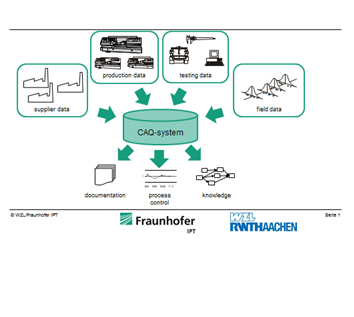Computer aided quality systems

Satisfying users in the turbomachinery industry is not only about building excellent equipment. It also involves delivering the right product-related information and documentation. This content is determined by the various stakeholders: Apart from existing laws and regulations accompanying this area, more and more users demand individual information and documentation to comply with their specific technical, legal or client-side requirements.
For manufacturers, this typically means collecting, processing and aggregating data from different suppliers, production steps and tests. What sounds easy at first glance quickly becomes difficult in reality. Production processes are technologically challenging. Findings from tests and inspections are usually stored in individual databases. Paperwork is produced and scattered among all departments involved. Product data and certifications from suppliers are often available only as printouts. If digitized, they are stored in differing formats and media. The result is that it typically takes a monumental effort to ensure that the required documentation can be handed over to the customer at the right time and within the right specifications.
To overcome loss of information and reduce efforts to gain product- and production-related knowledge, Computer Aided Quality (CAQ) is a step in the right direction – if it is implemented and used in the right way. A CAQ system is basically a large, central database connecting production and adjacent processes on a high level of detail. Manufacturing dimensions and information are logged for each part, as well as findings of all tests and inspections performed, from visual to X-ray to the output of a coordinate measurement machine. Additional documents and certifications can be stored and managed.
The best reason to implement CAQ is the tracking and reproduction of product-related data along the value chain or over its lifecycle. Additionally, gaining knowledge from well-understood, stable production processes to facilitate the implementation of new products is one major advantage often approved. Furthermore, these processes (e.g. milling, grinding) can be monitored and controlled with tools such as statistical process control (SPC).
By storing everything within one database, aggregating documentation is achieved with less effort. By also serving as a record of historic product data, CAQ can be of assistance in the occurrence of failure in the field.
CAQ in turbomachinery
Establishing one central system is both ambitious and risky. Data sources among enterprises are usually widespread and heterogeneous. Implementing interfaces for each of them easily becomes the major cost driver for such a project. Furthermore, the availability of the system needs to be rather high, as it directly supports value creating processes. This strongly influences the design of the system, e.g. server redundancy or maintenance cycles. Last but not least, establishing a central system usually requires the change of existing processes and procedures. Beyond technical questions this has an interpersonal side – people along numerous departments and positions need to be convinced of and included into fundamental decisions. A large share of the problems for widespread CAQ systems occurs in this rather emotional sphere.
A profound analysis forms the base for every successful CAQ implementation: What processes need to be considered? What exactly is the required functionality? Which departments are affected? Who are the necessary decision makers and opinion leaders that need to be included? On a technical side, this requires a detailed analysis of the existing data sources and – even more important – a clear prioritization with hindsight to the cost of individual interfaces.
The market for suppliers of CAQ systems has expanded lately. Before asking for quotes and narrowing the corridor of options, it is important to understand that a CAQ system is not necessarily a stand-alone solution. Most manufacturers already feature an Enterprise Resource System (ERP) such as SAP or even a Manufacturing Execution Systems (MES). A large share of the suppliers for these systems offer at least parts of the functionalities of CAQ. Furthermore, the efforts and costs for interfaces to existing systems can play a major part in any related business case.
Computer Aided Quality offers a wide range of opportunities regarding data management in the manufacturing of turbo machinery. They can help to reduce efforts for collecting and processing data and thus improve customer satisfaction regarding technical documentation. Planning and implementing such a system can become quite a challenging task both on a technical and a management side, as numerous data sources, processes and departments have to be considered and decision makers as well as opinion leaders convinced to support the system.
Fuel Flexibility in Heavy-Duty Gas Turbines: A Key Driver for Energy Transition
March 13th 2025From Hydrogen to HVO, Mr. Federico Bonzani, Chief Technology Officer of Ansaldo Energia, describes the fuel flexibility state-of-the-art solutions of the Company to meet the actual and future needs of power generation industry.